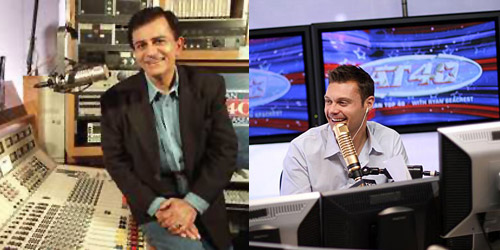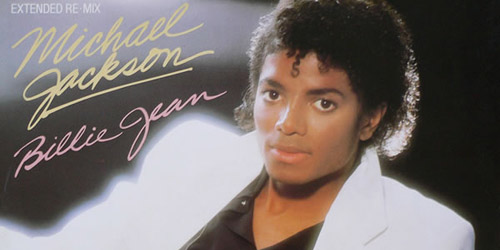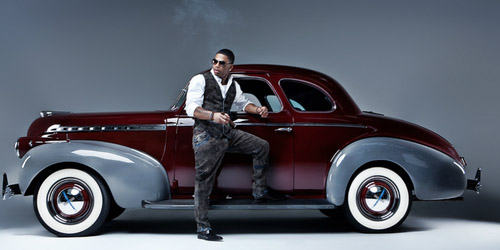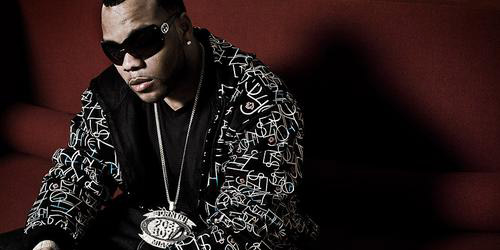
The hits from host to host.
“Listen to the countdown; they’re playing our song again.” That’s a line from the 1979 #1 hit by M, “Pop Muzik”. If you were alive then, you probably heard that song a lot, but at least a few times listening to a countdown show. Give that line to any current-day star to sing and your average teen listener wouldn’t know what they were talking about. “A countdown show? Isn’t that what my mom used to listen to?” Unfortunately, for most of us chart fans out there, a music countdown show that can clearly tell you what song is at what position on the national scene is nothing but a memory, but it didn’t have to be that way.
Let’s go back to 1970. Two men came together in Hollywood to make a weekly three-hour radio show that played all forty songs at the top of Billboard’s Pop Singles (later Hot 100) list. It debuted on the July 4 weekend: American Top 40, hosted by Casey Kasem, co-created with Don Bustany. It started on a handful of stations and for the first few years, and wasn’t generating enough revenue to keep it afloat. Yet, it was the combination of the popular songs with a host who was more like a storyteller that kept people tuning in every week. You would hear tidbits about your favorite artists that you never knew before (and couldn’t find on Wikipedia nowadays either.) Plus, the show added an interactive element in that listeners could write in to have their music questions answered or send in a Long Distance Dedication (beginning in 1978) to someone who meant a lot to them. The show eventually expanded to four hours in October 1978 and that’s where it remained, still popular and giving stations the needed listenership they desired while entertaining the audience of several nations. In 1980, a weekly half-hour video program based off it, America’s Top 10, hosted by Kasem, became syndicated.
Of course, the knockoffs began in stride, though most didn’t come until almost a decade afterward. Remember Countdown America, hosted by John Leader? Rockin’ America Top 30 Countdown, hosted by Scott Shannon? The National Music Survey, hosted by Dick Clark? Top 40 Satellite Survey, hosted by Dan Ingram? Some of the names are probably familiar to you, like the late multi-talented Clark, or Shannon, who is the morning DJ at WPLJ-FM in New York City. Only one non-AT40 show from that era managed to stay on the air to this day: Rick Dees and his Weekly Top 40, which debuted in 1983. A few versions are syndicated each week, and you still can’t hear “Disco Duck” on any of them. Yet, somehow, Kasem and his countdown managed to stay ahead of the competition.
By 1988, Kasem was in contract disputes with ABC Watermark and they let him go, hiring Shadoe Stevens to replace him. If you’re a late night fan, you’d probably recognize him as the voiceover artist behind The Late Late Show with Craig Ferguson. Stevens brought a different delivery to the show, but he had an eagerness and enthusiasm to do the countdown every week, though he did have his share of critics. However, he kept with routine of relaying interesting stories and facts about the artists and added some new features as time went on, like a flashback and a sneak peek segment, where the top new song added to CHR radio that week was highlighted. Plus, he had a Whiplash Acrobatic Ensemble. It’s not like anyone else is going to recognize their staff as that. While he did that, Kasem headed to Westwood One to host Casey’s Top 40, which was AT40 with a few minor tweaks: the Long Distance Dedication, which remained with Stevens, became known as a Request & Dedication with Kasem, and the chart source changed. Stevens counted down the Hot 100; Kasem took on the Radio & Records chart, which Dees was also using on his show. In 1992, Kasem began an AC-based show, Casey’s Countdown, and in 1994, a Hot AC show, Casey’s Hot 20.
Long story short: Stevens changed chart sources a few times after the Hot 100 changed its formula (which had a positive effect on rap records), his input on the show was diminished in later years (not his fault) and he was off the air in the States by the summer of 1994, replaced with Dees. However, American Top 40 still aired internationally until January 1995, when it was cancelled entirely and replaced with the World Chart Show. Yes, even though it celebrated a 40th anniversary back in 2010, the name was technically off-the-air for three years and change until March 1998, when Kasem jumped back from Westwood One to AM/FM (later Premiere Radio Networks) to host the countdown that was originally his. Westwood One planned to stop him with a show called Top 40 Countdown, hosted by either David Perry or Jeff Wyatt, both regional disc jockeys, but it never materialized as a full, weekly show. Kasem hosted AT40 until January 3, 2004 and his AC and Hot AC shows until July 4, 2009, and as far as I’m concerned, that’s where this story should have ended.
By November 2003, most of the radio industry knew that Kasem was being replaced by the host of American Idol, Ryan Seacrest. In fact, Seacrest guest-hosted AT40 in the fall of 2003, which showed him as a pretentious punk who wasn’t committed to making a serious effort. It was bad. So, come January 10, 2004 (yes, he’s entering his tenth year hosting this weekend), this disaster had to take the air. The imaging was updated, the chart source changed so that older songs re-entered the survey, sound bites were added and there was little chart information presented. Basically, it was a chart fan’s worst nightmare, and Seacrest seemed so smug about it. A “thank you” message to Kasem on the first show was followed with a remark that he if kept talking the way he did, he would “cry” in the same way that he did at some “love story movies,” said in gest. Really? A month after this aired, Seacrest replaced Rick Dees as the morning man at KIIS-FM in Los Angeles for “On Air With Ryan Seacrest”, where he has been since. That was hinted at in his first AT40 episode when he name-checked KIIS-FM disc jockeys in some off-the-script comments. It chugged along, gaining more international affiliates while simultaneously putting even more of a focus on celebrity rather the music, because obviously a long-standing music countdown really needs pre-recorded interviews to make it work. The chart itself was also two weeks behind the national statistics, which still happens today, and also shows what little effort is put in to make the music selections actually match the data out there. Did I mention they’ve played the wrong versions of songs for their entire run on?
The show’s gone from bad to worse since Seacrest’s morning show began airing daily on Clear Channel stations in 2008, who decided that as a cost-cutting measure, they should crush the dreams of talented enough people by filling the air for four hours a day with a satellite-delivered show. Perfect sense. All the interviews on American Top 40 are now cut and paste straight from that in order to fill time that doesn’t see Seacrest plugging his latest Kardashian family spinoff or contests on his website with some sponsor he’s partnering with. I mean, you actually want to air them again? Nobody listened to them in first place, so force them down a second time. Again, perfect sense. In a move several years ago, the radio company made AT40 a market exclusive in those stations with a CC-owned CHR or Hot AC station; thus, many long-running affiliates lost the show entirely. As of 2012, the main tagline used in the opening bumper of the show is now “the stars, the sleaze, and the hits”, which basically shows how much of an emphasis the show puts on the music countdown part of it if the music part has to come last. Oh, by the way, it’s referred to as “On Air With Ryan Seacrest on American Top 40” in some tags, as if he and corporate went in one day and were like, “we have to dumb this thing down even further so people know it’s the same damn show.” It’s a joke. It’s like his purposely taking the piss on himself. The problem is that people don’t care about it. It’s not like a snarky tweet is going to do anything. We need action, not empty promises, and we’re at the point that this show is so far removed from its original intent that it should just go off the air, but it won’t.
Thus, the future of the countdown. I’m guessing that this will be the last year for the Dees countdown on the radio. It would be fitting simply for the fact that the Weekly Top 40 marks its 30th anniversary in the fall of this year and it would be a nice sort of way to go out. It’s not like I would be surprised if this didn’t happen, but the guy’s lost a lot of affiliates and isn’t hosting a morning show anymore. He’s had a good run, but he’s been running on the same tired material for years; time to think about packing it up. Most of the subsidiary countdowns, like the ones hosted by Hollywood Hamilton and Nick Cannon, will probably be gone in the next few years. They generally air in small markets anyways. All the country ones are safe: Kix Brooks, Lon Helton, Bob Kingsley, etc. Even the Atrocity Top 40 will be on until 2015; that’s when Seacrest’s contract with Clear Channel is up, but you’re probably going to see that renewed along with his expanded deal with NBC. Don’t get me started on how made television a steaming pile of mindless crap too.
So, am I unfairly targeting Seacrest as the scapegoat? Yes and no. Some of these changes to American Top 40 were more of a corporate decision, but since he’s a step away from owning the Clear Channel company, he would have to approve most of them. The writers can’t do anything substantial because it’s probably at the point where Seacrest does his talk breaks in one-half hour on a Monday morning before pitching another reality show. It’s not like the producers can help it either when they have so little to work to with. I’m not in his target audience, I realize that. Am I frustrated that I could never host American Top 40? Well, duh, the traditionalist in me would have set it straight in a way that honored Kasem’s legacy rather than turning into a gossip show that can’t even stand on its own without being umbrellaed under another name. My personal top 40 was inspired from sitting on the floor of my room on Sunday morning listening to Kasem’s broadcast on the radio, but this doesn’t count in the real world. The countdown show of yesterday has been gone for the years, and the “countdown show” of today is slowly crawling towards its death. I can’t say for sure when it’ll end, and when it does, I doubt many people are going to notice. As much as I would love someone to come and start a countdown revolution (I would write and record the whole thing if I could) it’ll never happen, and you’ll still never know where your favorite song is on the chart because the artist, title and position were never announced.
Between the changing chart sources, music genre shifts, and a host who prefers breaking celebrity stories instead of breaking new artists, much has gone wrong with respect to the top-40 countdown. Thus, it’s too late to repair for the next generation. If you must, listen to the old Casey Kasem shows and relive the nostalgia of what was the perfect balance of music and trivia and not the current-day schlock. When Kasem said to “keep reaching for the stars,” Seacrest, he didn’t mean the ones you see in the press. Goodness.











